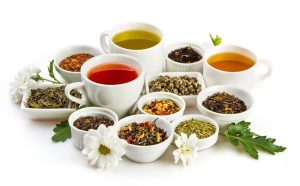The Chinese are famous tea-lovers. From your taxi driver to your bank manager, wherever you go in China, every person you see will have a personal thermos with leaves brewing in it. The Chinese tea culture is incredibly rich, and nowhere in the world will you find more varieties of this plant – and of ways to process and serve it. The differences stem mainly from the crop from which the tea was taken, and its full/partial/no fermentation.

But what is the tea plant? The plant used for tea is the Camellia sinensis (Chinese camellia). It originated in southwestern China, where it was used as a medical brew. During the Tang dynasty (618-907 CE), it became a popular everyday drink and spread throughout East Asia.
Today, after thousands of years of tea culture, Chinese tea is divided into five categories according to the liquid’s color and its effects on the body. NOTE: the tea that we call “black” tea (i.e., the “regular” tea, named for the color of its leaves) is what the Chinese call “red” tea (named for the color of the liquid).
Here are the main classifications:
- Green tea – unfermented tea. Cool, slightly bitter and astringent. Suitable to drink in the summer, in hot and humid weather. Unsuitable for people suffering from “inner cold” (a common concept in Chinese medicine), abdominal pains, etc.
- Oolong tea – semi-fermented tea. Cool, slightly bitter and sweet, either fruity with honey aromas or woody and thick with roasted aromas. A good fat dissolver that helps digestion after large meals, and thus known in China as a diet tea. Suitable to drink in fall and in winter. Unsuitable for people suffering from “inner cold” and pains.
- Red tea (known in the west as black tea) – fully fermented tea. Warm, slightly sweet and floral. Suitable to drink in winter and in spring. Also suitable for people suffering from “inner cold” and pains.
- Black tea – fully fermented tea. Warm, slightly bitter, with grassy notes. Due to its fermentation process, it is recommended to drink older tea of this variety. Suitable to drink in winter and in spring, also for people suffering from “inner cold” and pains.
- Jasmine tea – an unfermented mixture of green tea with jasmine flowers. Cool and slightly bitter. Suitable to drink in summer, during hot and humid weather. Unsuitable for people suffering from “inner cold” and pains.
Tea is best had after meals and not before, as continued drinking of tea on an empty stomach can cause abdominal problems.
Enjoy!

